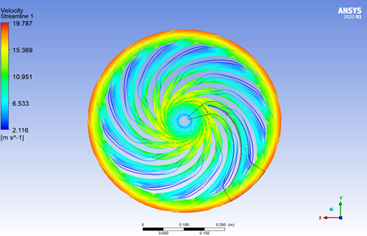CFD Analysis of the Flow in the Impeller of a Turbopump
DOI:
https://doi.org/10.14295/vetor.v32i2.14274Keywords:
Computational Fluid Dynamics, Turbomachines, Numerical AnalysisAbstract
Centrifugal pumps are widely used in a myriad of applications, such as industry, agriculture, and residential, among others. These devices are often used nonstop, thus playing an important role in energy consumption. Therefore, the improvement of the design of these devices results in dramatic cost reduction. The present work used Computational Fluid Dynamic (CFD) as a tool for designing the impeller of a turbopump. The main objective was to obtain the maximum head provided to the fluid being pumped. The Ansys® software was used to obtain the simulated results. The turbulence model used was the κ-ε. In this work the interaction between the impeller and the casing was not considered. Both the geometric parameters and the number of blades of a predefined impeller configuration were modified to obtain the maximum head. A 12% increase in the head provided by the impeller was obtained when the number of blades was increased from 6 to 13.
Downloads
References
H. Keck e M. Sick, “Thirty years of numerical flow simulation in hydraulic turbomachines,” Acta Mechanica, vol. 201, no. 1–4, pp. 211–229, 2008, Disponível em: https://doi.org/10.1007/s00707-008-0060-4
H. M. P. Rosa e B. S. Emerick, “CFD Simulation of a Centrifugal Pump Impeller with Variations of Number of Blades,” The Journal of Engineering and Exact Sciences, vol. 4, no. 2, pp. 0220–0224, 2018, Disponível em: https://doi.org/10.18540/jcecvl4iss2pp0220-0224.
H. M. P. Rosa e B. S. Emerick, “CFD simulation on centrifugal pump impeller with splitter blades,” Revista Brasileira de Engenharia Agrícola e Ambiental, vol. 24, no. 1, pp. 3–7, 2020, Disponível em: https://doi.org/10.1590/1807-1929/agriambi.v24n1p3-7.
L. Ji, W. Li, W. Shi, F. Tian, e R. Agarwal, “Effect of blade thickness on rotating stall of mixed-flow pump using entropy generation analysis,” Energy, vol. 236, pp. 121381, 2021, Disponível em: https://doi.org/10.1016/j.energy.2021.121381.
I. Chalghoum, H. Kanfoudi, S. Elaoud, M. Akrout, e R. Zgolli, “Numerical Modeling of the Flow Inside a Centrifugal Pump: Influence of Impeller–Volute Interaction on Velocity and Pressure Fields,” Arabian Journal for Science and Engineering, vol. 41, no. 11, pp. 4463–4476, 2016, Disponível em: https://doi.org/10.1007/s13369-016-2157-8.
Y. Wu, X. Chen, H.-S. Dou, L. Zheng, Z. Zhu, B. Cui, e B. C. Khoo, “Numerical simulation and analysis of flow characteristics in the front chamber of a centrifugal pump,” Journal of Mechanical Science and Technology, vol. 31, pp. 5131–5140, 2017, Disponível em: https://doi.org/10.1007/s12206-017-1007-2.
R. Dunaiski, “Simulação numérica do escoamento monofásico em uma bomba centrífuga radial,” Dissertação de Mestrado, Universidade Tecnológica Federal do Paraná, Curitiba, 2015. [Online]. Disponível em: https://repositorio.utfpr.edu.br/jspui/bitstream/1/1795/1/CT_PPGEM_M_Dunaiski%2C%20Rafael_2015.pdf
Turbulência: Anais da I Escola de Primavera em Transição e Turbulência. Rio de Janeiro: ABCM, 1998. Acessado: 13 de abril de 2022. [Online]. Disponível em: https://abcm.org.br/app/webroot/anais/eptt/turbulencia.pdf
A. da S. Neto, “Fundamentos da turbulência nos fluidos”. [Online]. Disponível em: https://abcm.org.br/app/webroot/anais/eptt/2002/Cap1-ASilveiraNeto.pdf
A. P. S. Freire, “Introdução à Turbulência”. Acessado: 8 de abril de 2022. [Online]. Disponível em: http://www.turbulencia.coppe.ufrj.br/notas_aulas/CursoTurbulencia_APSF.pdf
C. D. Argyropoulos e N. C. Markatos, “Recent advances on the numerical modelling of turbulent flows,” Applied Mathematical Modelling, vol. 39, no. 2, pp. 693–732, 2015, Disponível em: https://doi.org/10.1016/j.apm.2014.07.001.
Introdução ao CFD - ANSYS/FLUENT / projeto de um separador ciclônico - escoamentos multifásicos, (27 de outubro de 2021). Acessado: 8 de abril de 2022. [Online Video]. Disponível em: https://www.youtube.com/watch?v=6pWhUWXGX2Y
P. A. Durbin e B. A. P. Reif, Statistical Theory and Modeling for Turbulent Flows: Durbin/Statistical Theory and Modeling for Turbulent Flows. Chichester, UK: John Wiley & Sons, Ltd, 2010. Disponível em: https://doi.org/10.1002/9780470972076.
S. B. Pope, Turbulent flows, 12a impressão. Cambridge: Cambridge Univ. Press, 2015.
F. M. White, Viscous fluid flow, 3a edição. Boston, Mass.: McGraw-Hill, 2006.
Turbulência: Anais da V Escola de Primavera em Transição e Turbulência, vol. 2. Rio de Janeiro: ABCM, 2006. Acessado: 13 de abril de 2022. [Online]. Disponível em: https://www.abcm.org.br/anais/eptt/2006/artigos para o site/Turbulencia_V5_T2.pdf
H. K. Versteeg e W. Malalasekera, An introduction to computational fluid dynamics: the finite volume method, 2a edição, Harlow: Pearson/Prentice Hall, 2007.
Ansys Inc., “Ansys Fluent Theory Guide”. julho de 2021. [Online]. Disponível em: www.ansys.com
H. Schlichting e K. Gersten, Boundary-Layer Theory. Berlin, Heidelberg: Springer Berlin Heidelberg, 2017. doi: 10.1007/978-3-662-52919-5.
P. S. Bernard e J. M. Wallace, Turbulent flow: analysis, measurement, and prediction. Hoboken, NJ: Wiley, 2002.
J. W. Mitchell, R. W. Fox, e A. T. McDonald, Fox and McDonald’s Introduction to Fluid Mechanics, 10a edição, EMEA edition. Hoboken: Wiley, 2020.

















